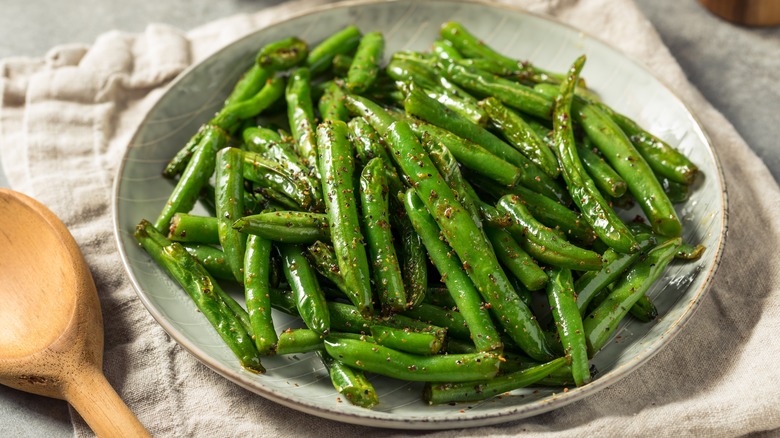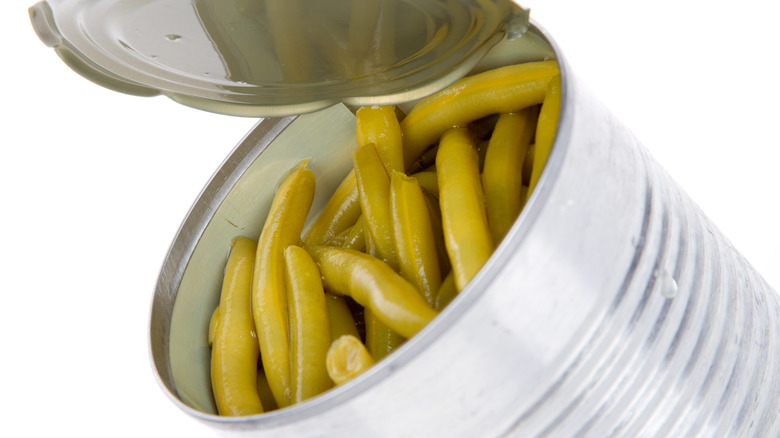The Nutritional Differences Between Canned Green Beans And Fresh
Green beans, snap beans, or string beans — however you address this ubiquitous garden favorite, you should know it's a nutritional powerhouse. Like most fruits and vegetables, adding green beans to your daily meal results in a higher nutrient intake while introducing a naturally low fat and low calorie food. Whether you prefer your green beans boiled, roasted, or made in the air fryer, there's a reason your parents told you to eat your beans, and it's because they're good for you.
However, there's a vast array of ways to process, store, and prepare green beans, and it's fair to say each of those steps has the potential to reduce the amount of nutritional goodness green beans deliver. By the time store bought canned green beans reach the table, they've been heated, salted, stored, and shipped. So, you might be thinking, "Are canned green beans as healthy as fresh green beans?" The answer is not quite. However, if the question is, "Are canned green beans healthy?" the answer is a resounding yes.
How fresh and canned are similar
According to the USDA, one cup of fresh green beans contains 31 calories. In contrast, canned green beans have a slightly lower 24 calories. Either version has a nearly immeasurable amount of fat (less than one gram), making it a low-fat, cholesterol-free choice whether they're fresh or canned. One redeeming quality of green beans is they are high in fiber, which is responsible for helping you feel full longer and aiding in digestion. Fresh green beans contain over three grams while canned are lower at just less than two grams.
Fresh and canned green beans have nearly identical amounts of calcium at 37 and 36 milligrams, respectively. They are also close in iron and zinc content. Both options provide folate, which helps keep anemia at bay, although fresh green beans contain 33 micrograms, while canned present 23 micrograms. Up and down the list of many nutrients, fresh outpaces canned green beans by a small amount, although both options have a place in the kitchen. Whether you like to add anchovies for a hint of salt and flavor or want to spruce up your green bean casserole, green beans will add nutritional value. However, there are some nutritional differences between canned and fresh green beans that are worth noting.
How they differ
Although canned green beans are processed soon after being picked from the plant, they do lose some essential minerals in the process. For example, canned green beans are significantly lower in vitamin C, with just 2½ milligrams compared to over 12 milligrams for fresh beans. There's also a remarkable difference in the amount of potassium, with fresh green beans measuring 211 milligrams and canned less than half of that amount.
Perhaps the most notable difference between fresh and canned green beans is the amount of sodium. Where a cup of fresh beans nets six milligrams of sodium, the same amount from a can contains a stunning 282 milligrams. However, there are low-sodium options, and rinsing canned beans before consumption lowers the amount of sodium, too.
Even with these differences, there are many reasons to include canned green beans in your pantry store. They are shelf-stable food, and they cook quickly, so they are convenient for weeknight dinners. They may also cost less than the fresh variety. So, while in a head to head competition, fresh green beans win the nutritional race by a hair, when it comes to choosing foods with high nutritional value, even green beans from a can leave many other foods in the dust. The bottom line is if you have fresh green beans, great. But if you don't, embrace the nearly equal canned version — just give them a rinse first.


